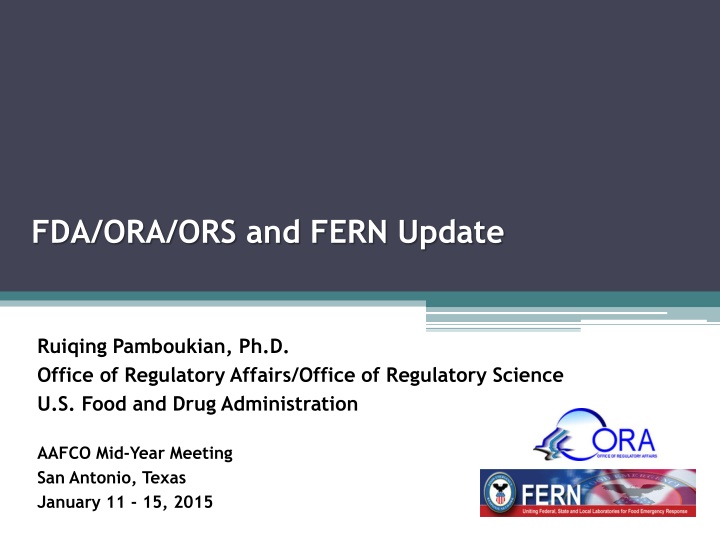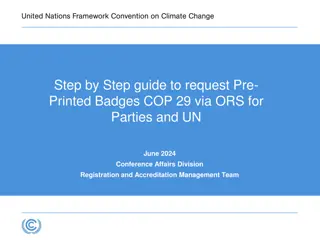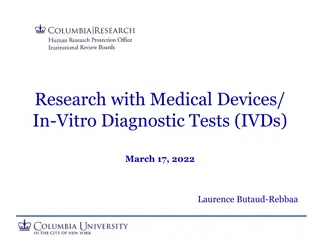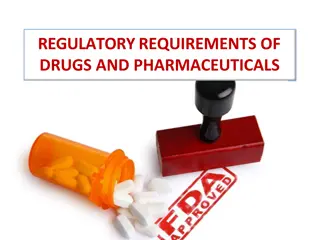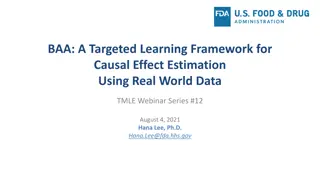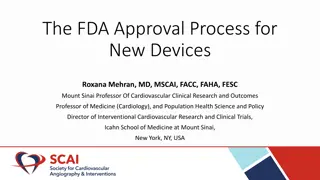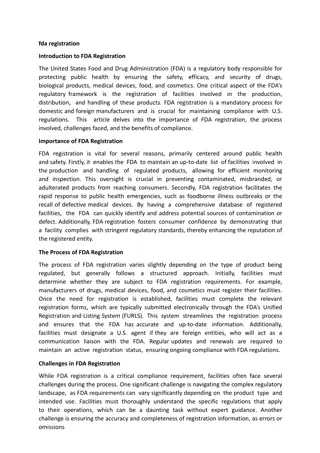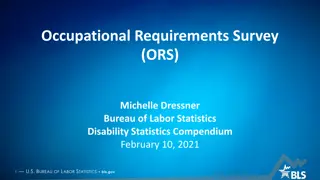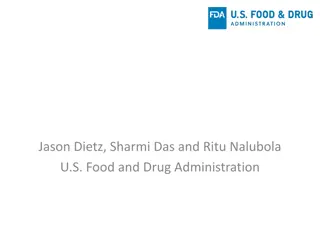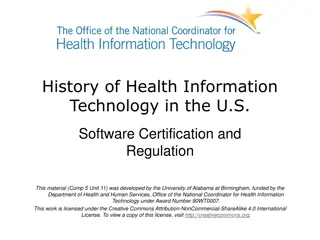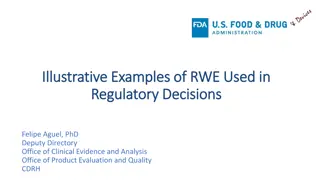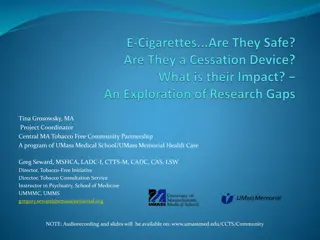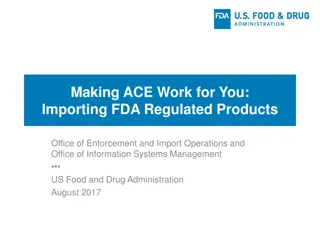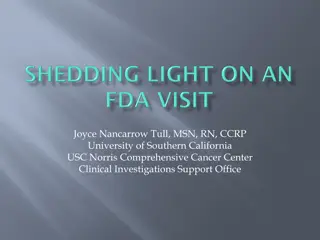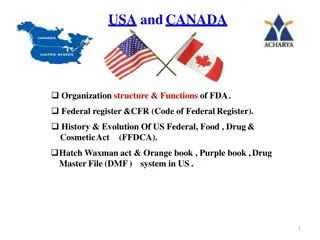Overview of FDA Office of Regulatory Affairs (ORA) and Office of Regulatory Science (ORS)
This information provides insights into the organizational structure and functions of the FDA Office of Regulatory Affairs (ORA) and the Office of Regulatory Science (ORS). It includes organizational charts, details about ORA laboratory locations, and the local structure of an ORA laboratory. Additionally, it mentions key personnel, such as the ORS Director and Deputy Directors. Links to relevant websites are also provided.
Download Presentation

Please find below an Image/Link to download the presentation.
The content on the website is provided AS IS for your information and personal use only. It may not be sold, licensed, or shared on other websites without obtaining consent from the author.If you encounter any issues during the download, it is possible that the publisher has removed the file from their server.
You are allowed to download the files provided on this website for personal or commercial use, subject to the condition that they are used lawfully. All files are the property of their respective owners.
The content on the website is provided AS IS for your information and personal use only. It may not be sold, licensed, or shared on other websites without obtaining consent from the author.
E N D
Presentation Transcript
FDA/ORA/ORS and FERN Update Ruiqing Pamboukian, Ph.D. Office of Regulatory Affairs/Office of Regulatory Science U.S. Food and Drug Administration AAFCO Mid-Year Meeting San Antonio, Texas January 11 - 15, 2015
2 ORA Organizational Chart
3 Office of Operations Office of Operations Office of Medical Products and Tobacco Operations Office of Enforcement and Import Operations Office of Food and Feed Operations Office of ORA Regions Regulatory Science Food and Feed Scientific Staff Northeast Region Medical Products and tobacco Scientific Staff Southeast Region Laboratory Operations and Support Staff Central Region Southwest Region Pacific Region
Office of Regulatory Science (ORS) organizational chart ORS Director Brian Baker (acting) Deputy Director of Medical Products and Tobacco Selen Stromgren Deputy Director of Food and Feed Tim McGrath Laboratory Operations and Support Staff Director: LCDR Jean Paul Food and Feed Scientific Staff Director: Michael McLaughlin Medical Products and Tobacco Staff Director: George Salem
5 ORS Website http://inside.fda.gov:9003/ORA/OfficeofRegionalOperations/Division ofFieldScience/default.htm
6 ORA Laboratory Locations FCC Cincinnati, OH Forensic Chemistry WA MA NY MI PA WEAC Winchester, MA Radionuclides OH KS CA CO AR GA PR ORA Regulatory Lab ORA Regulatory/Specialty Lab
7 Local Structure of an ORA Laboratory ORA Science Executive at Office of Reg Science Regional Food and Drug Director (RFDD) Current line of command Future line of command Lab Director Chemistry Branch Director Quality System Manager Microbiology Branch Director Drug Chemistry Supervisor Food Chemistry Supervisor Analysts Lab Technicians Sensory/Filth Supervisor* Micro Supervisor Support Staff: Admin Industrial Hygienist Sample Custodian Analysts Lab Technicians *Sensory/Filth groups may also appear under Chemistry Branch in some labs organization.
Roles and Responsibilities Food and Feed Scientific Staff The Food and Feed Scientific Staff (FFSS) responsibilities cover scientific issues (e.g. methodology, lab selection) involving food and feed testing conducted under FDA jurisdiction. Their testing coordination activities involve the 13 labs in the FDA/ORA network as well as the cooperative agreement laboratories within the Food Emergency Response Network (FERN). The staff coordinates various testing assignments and programs involving numerous FDA food safety issues as well as FERN activities.
Roles and Responsibilities Food and Feed Scientific Staff Examples include: Import and Domestic Acidified and Low-Acid Canned Foods Domestic and Imported Cheese and Cheese Products Pesticides and Industrial Chemicals in Domestic and Imported Foods Domestic and Imported Fish and Fishery Products Infant Formula Program Deep Water Horizon Testing Program (Reopening of Gulf States fisheries) FERN: Proficiency testing Program, training program, Cooperative Agreement Program ISO Laboratory Accreditation Program
Roles and Responsibilities Medical Products and Tobacco Scientific Staff Coordinate all activities related to CDER, CDRH and CTP. Coordinate analytical response to pharmacy compounding events Coordinate and provide analytical/compliance strategy for drug/device/tobacco programs and assignments Solicit research interest from ORA laboratories in new method development/validation to bridge analytical gaps Manage and prioritize capital equipment budget Manage workplan projections in drug/device/tobacco arena Identify new technology platforms to perform program work Form collaborations with Centers on analytical projects
Roles and Responsibilities Laboratory Operations Scientific Staff Laboratory Information Management System (LIMS) Electronic Laboratory Exchange (eLEXNET) Mobile Labs, Chemistry and Microbiology screening labs FDA web posting Lab Information Bulletins (LIB) Method Development and Validation Program (MDVP) Component Automated Research Tracking System (CARTS) National Sample Distribution (NSD) Equipment purchasing: VITEK, VIDAS Technology transfer/development ORS Science Seminar. Whole Genome Sequence
12 ORA Labs Program Work Work plan Annual map for allocation of ORA resources (inspectional, collections, analytical testing) to different areas of concern. Centers, in dialogue with Field Committees, determine how ORA resources should be distributed. ORA utilizes analytical capabilities in areas of chemistry, microbiology, radiochemistry, and engineering to perform the designated program work. ORA supports the various Centers in the following areas of testing. Product Areas of Testing/Analytical Activities Performed by ORA Pesticides, dioxins, mycotoxins, chemotherapeutics, color additives, toxic metals, filth, select radioisotopes Foods & Feeds Pharmaceutical Products Active pharmaceutical ingredient testing, dissolution testing Risk-identified products such as infusion pumps, catheters, surgical tools Devices Flavor compounds in cigarettes, contaminants testing, substantial equivalence Tobacco Products Nanotechnology Method development and research activities All products Private lab package reviews Analysts-on-inspections
13 ORA Analytical Capability Snapshot Test Main Instrument Platform Targeted Analytes Representative Picture 200px-P%2Cp%27-dichlorodiphenyltrichloroethane Pesticide Testing (fresh produce) GCMSD, LC-MS/MS, GCQQQ Up to 670 pesticides covered 150px-Melamine Melamine Testing (pet food, dairy products, protein containing processed foods) GCMSD and LCMSMS Melamine, cyanuric acid, ammelide and ammeline Oil Markers Testing (seafood during Deepwater Horizon Oil Spill) LC-FLD and LCMSMS Polyaromatic hydrocarbons (12 total, 7 being carcinogenic), dispersant, toxic metals napthalene 200px-Naphthalene-2D-Skeletal 300px-Polychlorinated_biphenyl_structure Persistent Organic Pollutants Testing (feed, seafood) GC X GC TOF, HRMS 40 compounds that include dioxins, PCBs and PBDEs 220px-Gamma_Decay Radionuclide Testing (milk, fresh produce after Fuskushima Meltdown) Gamma counters Cs-134, Cs-137, I-131
14 Test Main Instrument Platform Targeted Analytes Representative Picture ANd9GcRdI1VgF88faARtplVZZNnRus47I5a9cJEAp46BTjlYigRsaHzTYOfE2lRP Filth Analysis (bulk ingredients) Optical Microscopes Insects, glass shards, metal scraps, etc Toxic Metals (candy, dinnerware, seafood, juice, rice) ICP-MS, portable XRF, HPLC-ICPMS (speciation), ICP-OES Pb, Hg, Cd, Cr, As, etc ANd9GcRNYHzeZz4wUlS8FIACwRqqA3G4W6ojAuGmOPWtRmdAVLkoxVMjcNsQQXQ ANd9GcSCzd7iwD_TehFHAa3JqBEBaYhAaO_TA40eH7OuNsoFDOmqRlMD4hAH3dXR ANd9GcToMB8oxBBzEcmfyKD3VsgyRBDWa_6lzp_KFPg9oLWlKZx1aiJdPUi2zis Microbiology (fresh produce, cheese, seafood, etc) ELISA tests, selective media, PCR, PFGE, WGS Salmonella, E. Coli, Shigella, Campylobacter, Cyclospora ANd9GcQ_caCr-KNG06zVL7QYuiQHJIbtUpWdSd-pYFN-mghQCHDrnajHWiimYWDg Mycotoxins (grains, nuts, seeds, juice) LCMSMS, HPLC Aflatoxin, patulin, deoxynivalenol, fumonisins, ochratoxin A Aflatoxin Acidified and Low-Acid Canned Foods (canned foods) pH Meters, headspace GCMS Preservation: pH and water activity
15 Test Main Instrument Platform Targeted Analytes Representative Picture Color / Food Additives (processed foods) TLC, LCMSMS Banned colors, additives such as rhodamine B, sulfites in shrimp, dried fruits/vegs, coumarin in vanilla products, nitrosamines in baby bottle nipples, benzoates in beverages Cosmetics (face creams, hair sprays, lipsticks, henna, hair/skin dyes) TLC, XRF, LCMSMS, ICP-MS, microbiological kits Metals, microbiological contamination ANd9GcSfV4x3XiA8WB0dbc4ff8qVrYnb6jtW0hKm-CRCJZG2Lq7_80Tu2orGT-A ANd9GcTqTWuB5-aosS2f2HBJaUeIywOHXzOpaVMVbje_PO4-L3o-poHi-IsM7CM Forensic Chemistry (drugs, tobacco, tampered products) General chemistry, microbiology, molecular methods Packaging features, product featuers, contaminant profiles, country-of-origin analysis Economic Adulteration (honey, maple syrup, pomegranate juice, olive oil, pet jerky treats, juices) GCMS, LCMSMS, HPLC, isotope ratio MS Anthocyanin pigment profile, sugar profile, fatty acid profile, protein profile ANd9GcTPB1xN_MxZMDOCSX19G3xVFP2WGSCmWpSy4Pqhsd3bH4QA8pORtSE6DJA Veterinary Drug Residues (seafood, milk) LCMSMS, LC-QTOF, ELISA Kits Vet drug residues such as chloramphenicols, fluorquinolones ANd9GcRHb9qDQ2MilmjgGlt8Dg12y-NBD1McodV6DcyLR8iZrf9wg3BGp7wJzTCz
16 Test Main Instrument Platform Targeted Analytes Representative Picture Pharmaceutical Survey Testing (finished dosage forms, raw APIs, parenterals, excipients) HPLC, dissolution apparati, spectroscopic techniques Drug potency, content uniformity, split pill testing, impurities testing Spiked Active Pharmaceutical Ingredients in Dietary Supplements (dietary supplements with health claims) LCMSMS Erectile dysfunction active drugs, weight loss drugs, anabolic steroids, mood-altering drugs Microbiology testing in drugs (finished dosage forms, injectables, parenteral bags, compounded human/vet products) Sterility testing equipment, endotoxin test strips Bacteria, fungi, bacterial endotoxins Consumer Complaints, Adverse Events and Outbreaks (drugs, foods, pet foods, devices) All available chemical, microbiological, physical tools Broad-band investigative testing to identify causative agent: chemical contaminant, microbiological agent, manufacturing defect, etc
17 Test Main Instrument Platform Targeted Analytes Representative Picture Shelf Life Extension Testing (finished dosage forms) HPLC, dissolution apparati, stability chambers Drug potency, dissolution, pH, water content, physical appearance, functionality tests Device Testing (thermometers, catheters, intrauterine devices, forceps, tubing, pumps, radiological health) Various instruments to conduct engineering investigations fracture/fatigue tests, software tests Medical devices, radiological health devices Tobacco Testing (cigarettes) LCMSMS, GCMS, Smoking Machines Flavor compounds, hazardous and potentially hazardous compound testing, nicotine levels, substantial equivalence testing Nanotechnology (dietary supplements, food packaging, feeds, sunscreens) Various physical chemistry instruments TEM, SEM, XRD, DLS Broad-band testing to characterize nanoparticles and elucidate their physico-chemical properties
18 Internal Collaboration Committees leading collaboration Scientific Collaboration areas: food and feed, medical device and radiation emitting product, Tabaco and pharmaceuticals CDER CDRH CTP 13 field labs CVM OP CFSAN ORS OFVM NCTR External Collaboration APHL AAFCO AFDO EPA CDC ACIL Networks: FERN ICLN NATRLN USDA CBP
19 ORA External Collaborations Food Emergency Response Network (FERN) State Labs Areas of interaction: Sample analysis (complementary capacity, surge capacity) Intelligence sharing Data sharing Augmentation of enforcement authority Capability sharing/building FERN labs augmented ORA analytical response in following incidents: Melamine Contamination in Foods/Feeds (2008) Deepwater Horizon Oil Spill (2010) Peanut Butter from Peanut Butter Corporation of America (2008) Toxic Metals Surveillance (2013-2014) High Volume Microbiology Surveillance Avocados (2014)
20 ORA External Collaborations Organization Interaction Association of Public Health Laboratories /Association of Food and Drug Officials/Association of American Feed Control Officials (APHL/AFDO/AAAFCO) Building a mutually reliant food/feed safety network of labs to promote food/feed safety. American Council of Independent Laboratories (ACIL) Collaborating on standardizing analytical requirements in submissions from private labs to ORA in preparation for conforming to FSMA mandates. Science Board to the FDA ORA is preparing for its cyclical Science Board Review (performed on a rotating basis for every Center/ORA). ORA has requested that the Science Board review ORA s investment in FERN and ISO Laboratory Accreditation as a mechanism to create increased laboratory food safety capacity. ORA s last Science Board review occurred in 2008. Centers for Disease Control (CDC) Analytical reliance: ORA obtained microbial ID, fungal sequencing training from CDC. Customs & Border Protection (CBP) Analytical reliance: CBP obtained training in melamine testing methods from ORA. North American Tobacco Research Laboratory Network (NATRLN) Alcohol and Tobacco Tax and Trade Bureau, FDA/CTP, FDA/ORA, Health Canada, CDC, USDA forum to collaborate on setting common tobacco standards: methods, terminology, etc
21 FERN Update FDA large scale surveillance assignment
BACKGROUND OF THE ASSIGNMENT The Food Safety Modernization Act (FSMA) outlines a new approach to food safety that is risk-informed and preventive in focus Sampling process - serves as a mechanism to actively identify risks and when possible identify areas where preventive controls can be put into place to better protect public health As FDA increases its understanding of the sources of contamination in high risk commodities/practices, it can more effectively allocate resources to address public health risks through compliance sampling, targeted sampling or other risk mitigation strategies. 22
WHY AVOCADO? A CFSAN working group was established to perform a five year review of microbiological sampling data. Development of a new analytical tool which calculated risk scores of each commodity collected and analyzed over the past five years based on the risk criteria Based on the ranking results from the analytical tool, the following commodities were selected for FY 2014: sprouts (seeds, spent irrigation water, and finished product), raw milk cheese (aged 60 days), and avocados (whole pit fruit and pulp) 23
WHY AVOCADO? FDA ranked foods based on a variety of criteria and identify three foods to serve as surveillance sampling pilot programs. Food consistently causing illnesses or linked to outbreaks High consumption level; and/or consumed by a high risk Ready-to-eat (RTE) food population Ingredient in ready-to-eat (RTE) products Food regularly comes in contact with contaminated sources (water, or soil or equipment) during growing, harvesting, processing, or at retail Food is intended to be cooked by consumer Processed or manufactured in a manner without a "kill step" 24
MORE INFORMATION CDC reported the rise of guacamole and salsa as common vehicles in foodborne outbreaks Emergence of Salsa and Guacamole as Frequent Vehicles of Foodborne Disease Outbreaks in the United States, 1973 2008 FDA s limited sampling of avocado indicates the potential for a high incidence of contamination in this commodity. Avocado products have been associated with six (6) recalls due to the presence of foodborne pathogens from 2004-2011: Salmonella in fresh avocado (n=1) and L. monocytogenes in frozen/processed products (n=5) 25
OBJECTIVES OF THE ASSIGMENT To explore new processes and parameters for sample collections and analysis that will enhance the current FDA system - usage of the FERN labs To fill knowledge gaps of microbiological hazards by determining the prevalence of selected microbiological hazards (Salmonella) in whole pit fresh avocados and L. monocytogenes in avocado pulp To take appropriate enforcement action when positive samples and environmental sampling findings are observed 26
REPORTING (FERN labs and FDA staff) eLEXNET project folder housed all documents related to the assignment Data reporting: FERN website activation module Emails FDA FACTS data entry Communication from ORS to CFSAN, district offices (both import and domestics) 27
RESULTS SUMMARY Labs # of POS MN 14 TX 10 (2 SLM) ~689 samples received ~682 sample analysis completed 70 L. mono confirmed and CRO (~18% soak method) - 1 confirmed L. mono (pulp method) 10 confirmed Salmonella positive (~1.4%) PA 8 WA 7 IL 5 FL 3 OH 3 NC 2 CO 2 VA 2 MI 2 NMSU 1 NH 1 RI 1 28
FERN LAB SAMPLE DISTRIBUTION 90 80 Number of Sample Received 70 60 50 40 30 20 10 0 NMSU OH MI MN VA NC IL TX WA PA RI FL CO NH States Receiving Samples 29
PFGE/SEROTYPING/WGS FL serves as the primary Listeria serotyping and PFGE lab 79 Isolates submitted for PFGE 232 Isolates submitted for serology ~106 uploads to the PulseNet Database via CFSAN WGS: 19 L. mono and 10 Salmonella isolates have been sequenced by FDA Labs. 30
31 Questions?
